GRAND COMPLCIATIONS vol. 2
Installation and outdoor sculptureHøvdingens kjære squaw får litt pizza i Mexico by
Akershus Kunstsenter, 2019
Group show with Lawrence Abu Hamdan (JO), Andrea Bakketun (NO), Sara Korshøj Christensen (DK), Nils Norman (UK), Slavs and Tatars (Several), Allyce Wood (US)
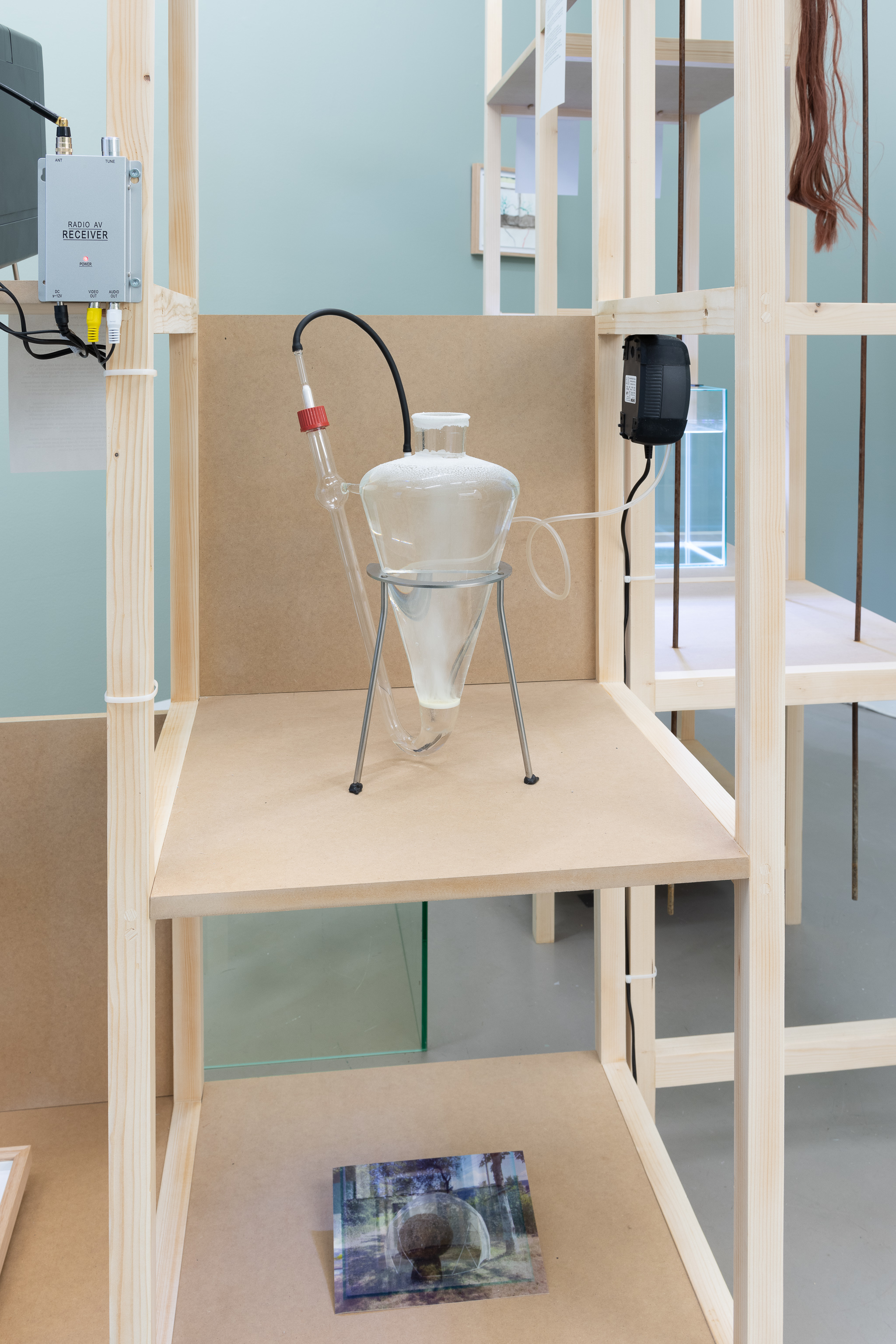 Installation detail, shelf with algae flask with air flow and salt solution, flyer
Installation detail, shelf with algae flask with air flow and salt solution, flyer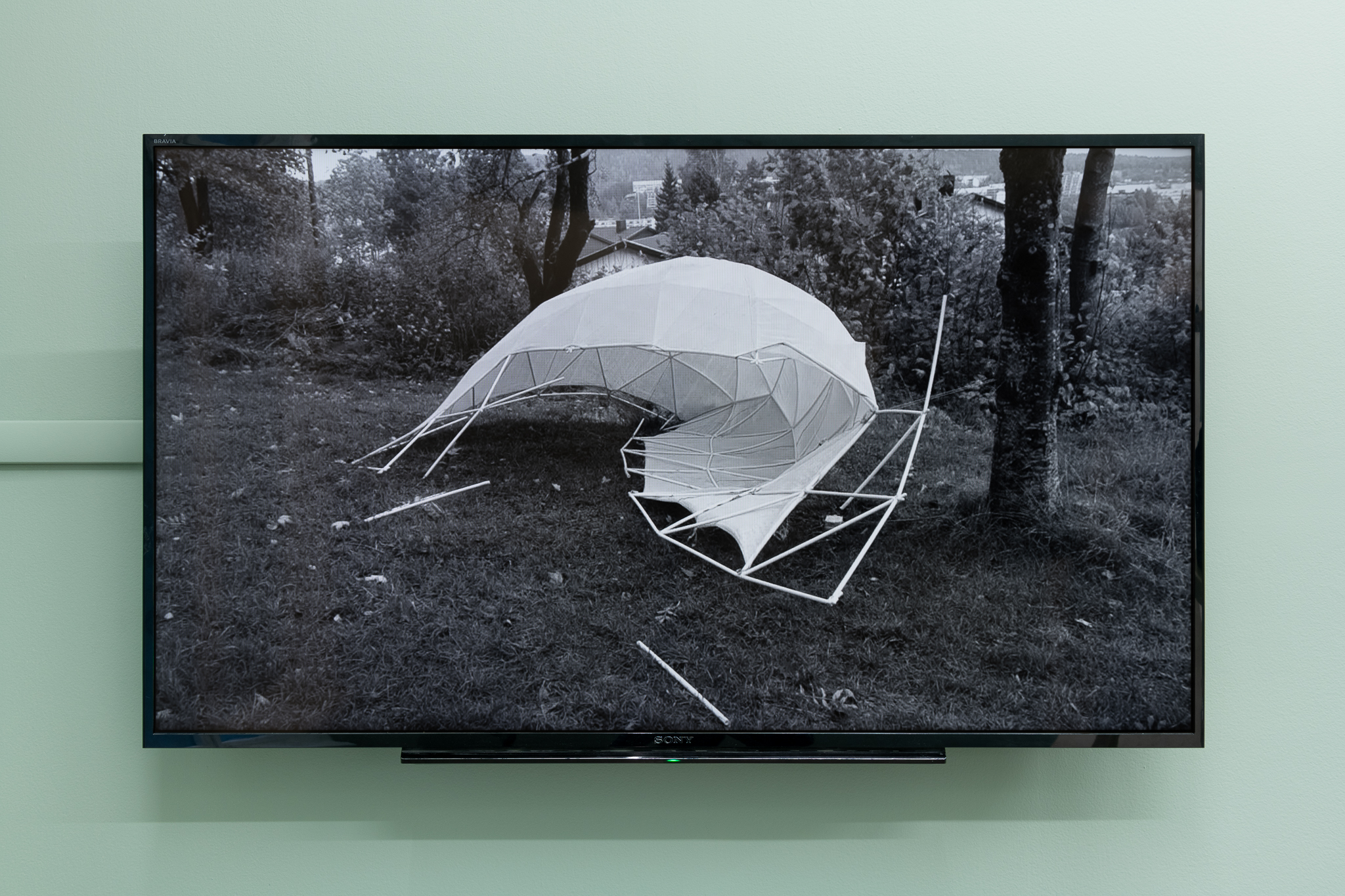 Installation detail, LED monitor with video loop
Installation detail, LED monitor with video loop
Digital video, 14:12 min
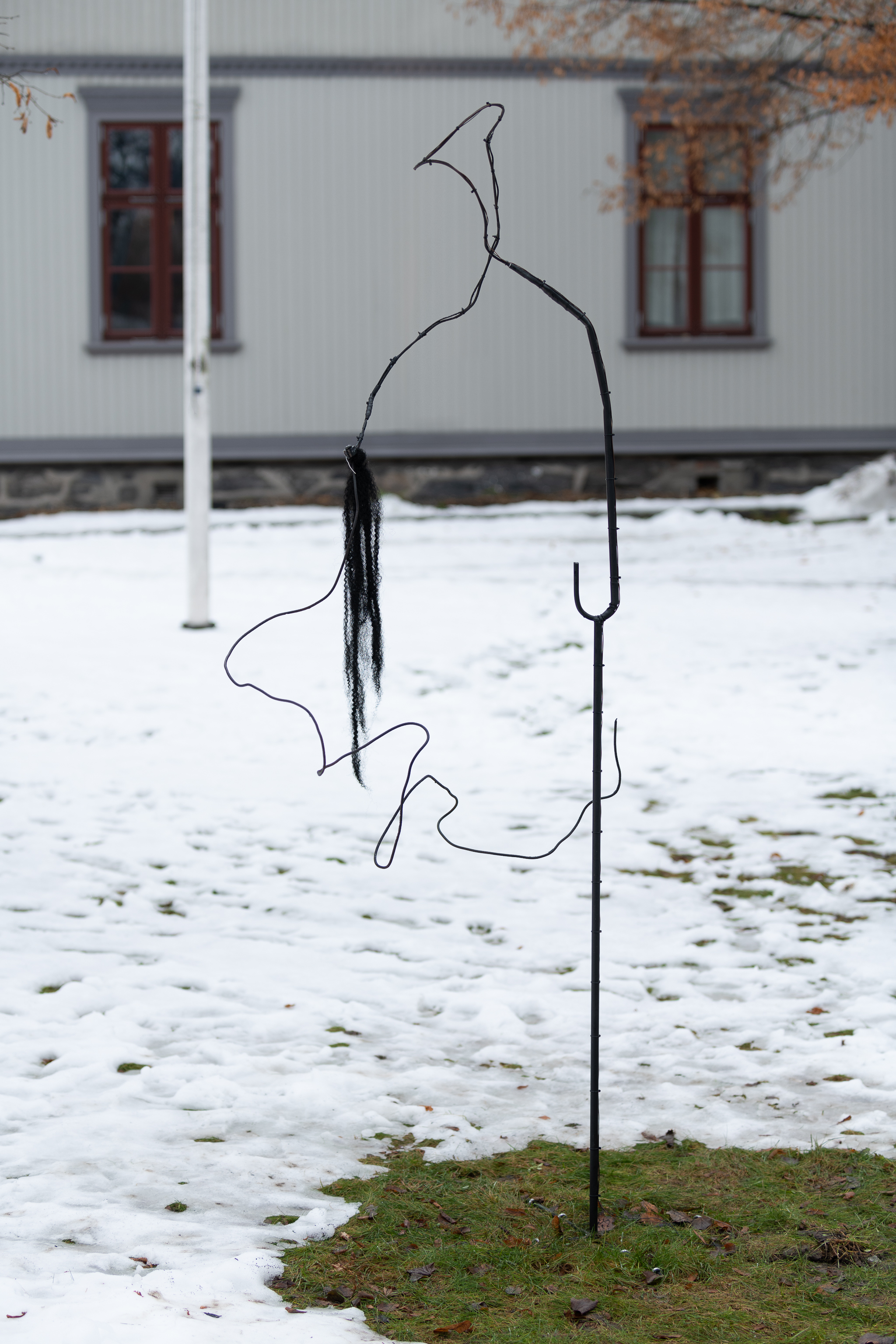
Outdoor sculpture, rubbercoated steel, artificial hair, pinhole camera
 Installation detail, shelf, aquarium, rock, UV-light, wood
Installation detail, shelf, aquarium, rock, UV-light, wood
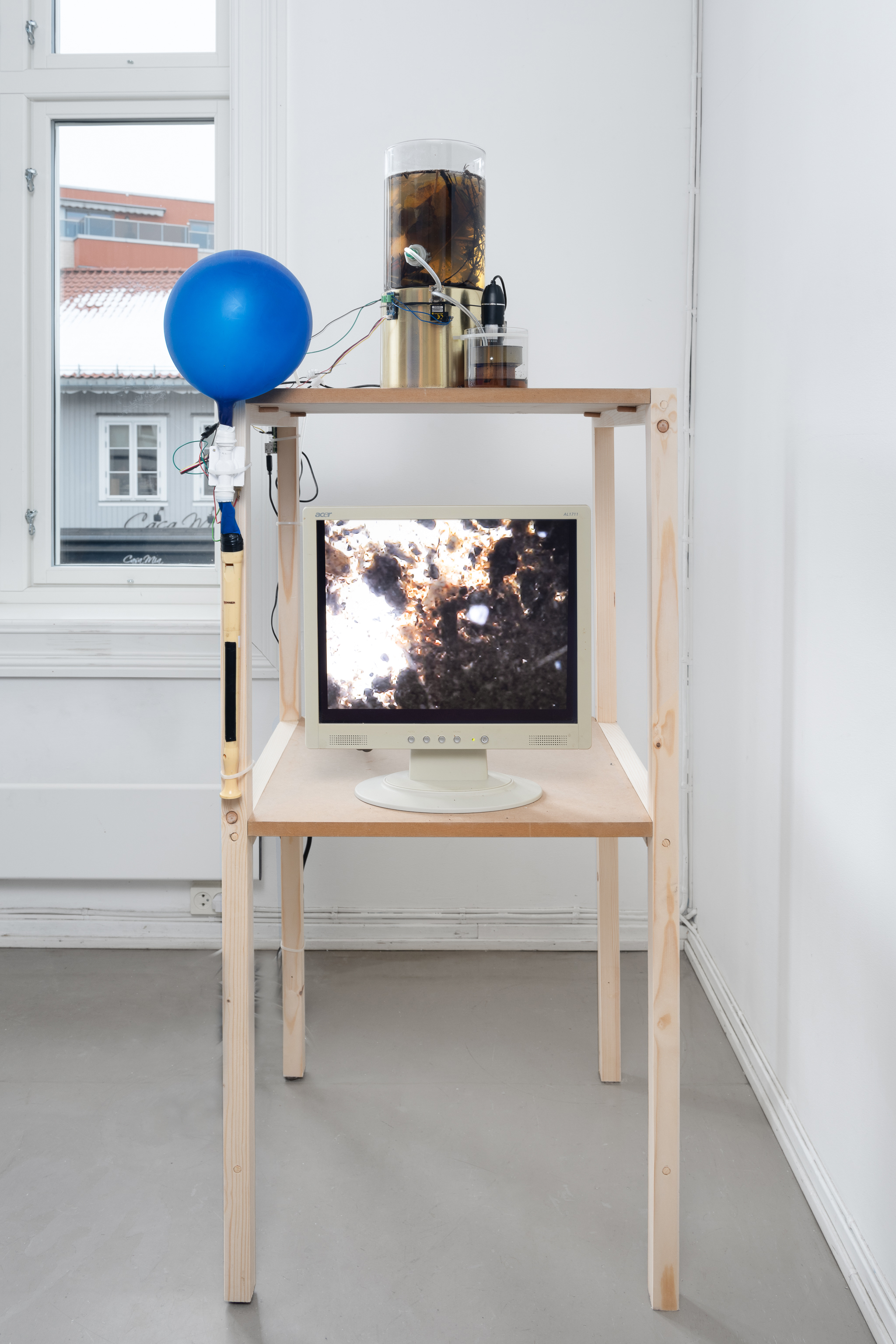 Installation detail, shelf, glass container with water and dried grass/leaves, surveillance chamber with mircoscope camera, video based movement sensor, recorder played by balloon with valve, reacting to movement in mirco-organisms detected by the sensor
Installation detail, shelf, glass container with water and dried grass/leaves, surveillance chamber with mircoscope camera, video based movement sensor, recorder played by balloon with valve, reacting to movement in mirco-organisms detected by the sensor
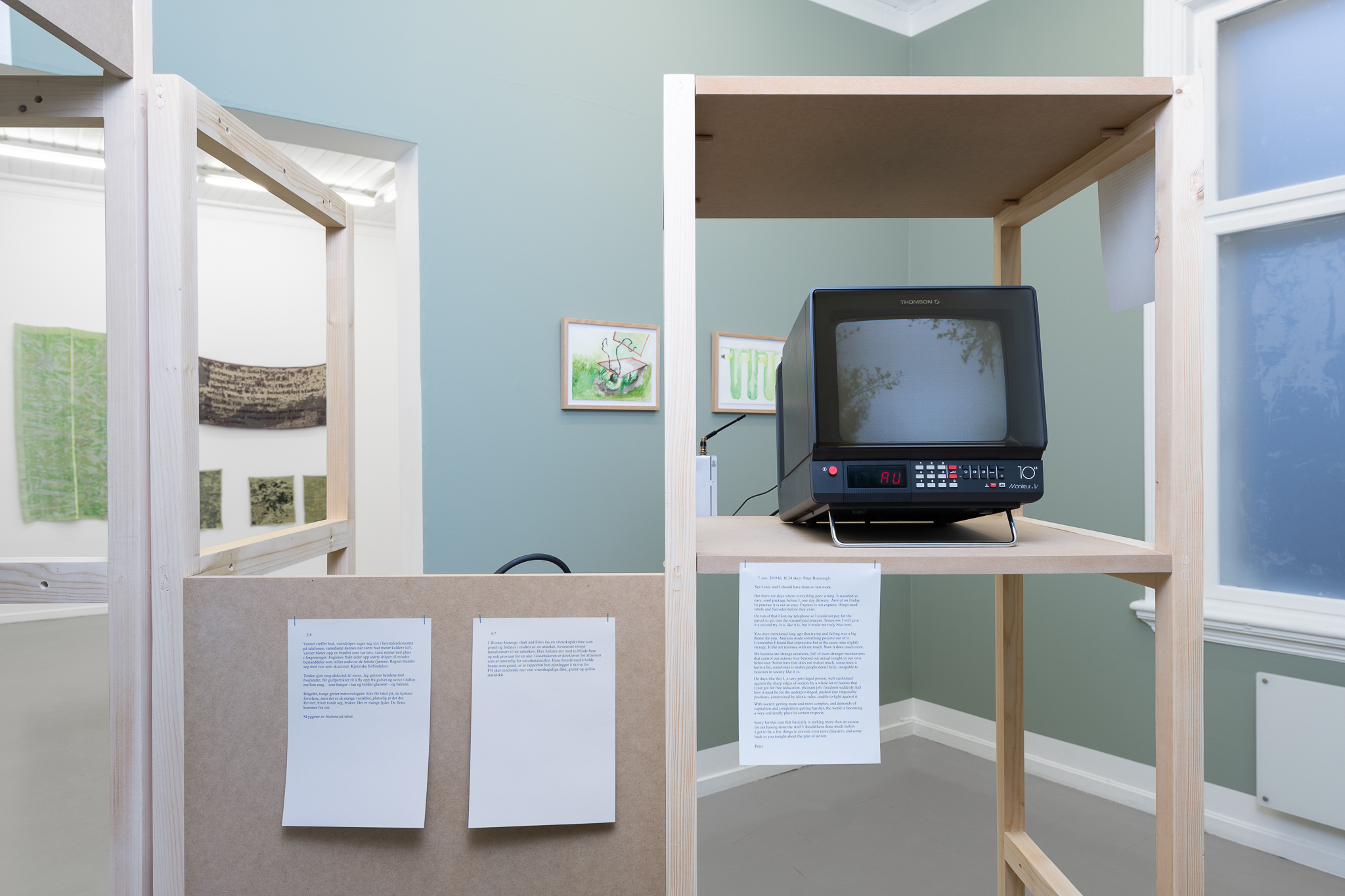 Installation detail, shelf, texts printed on paper, monitor with live stream from outdoor sculpture
Installation detail, shelf, texts printed on paper, monitor with live stream from outdoor sculpture
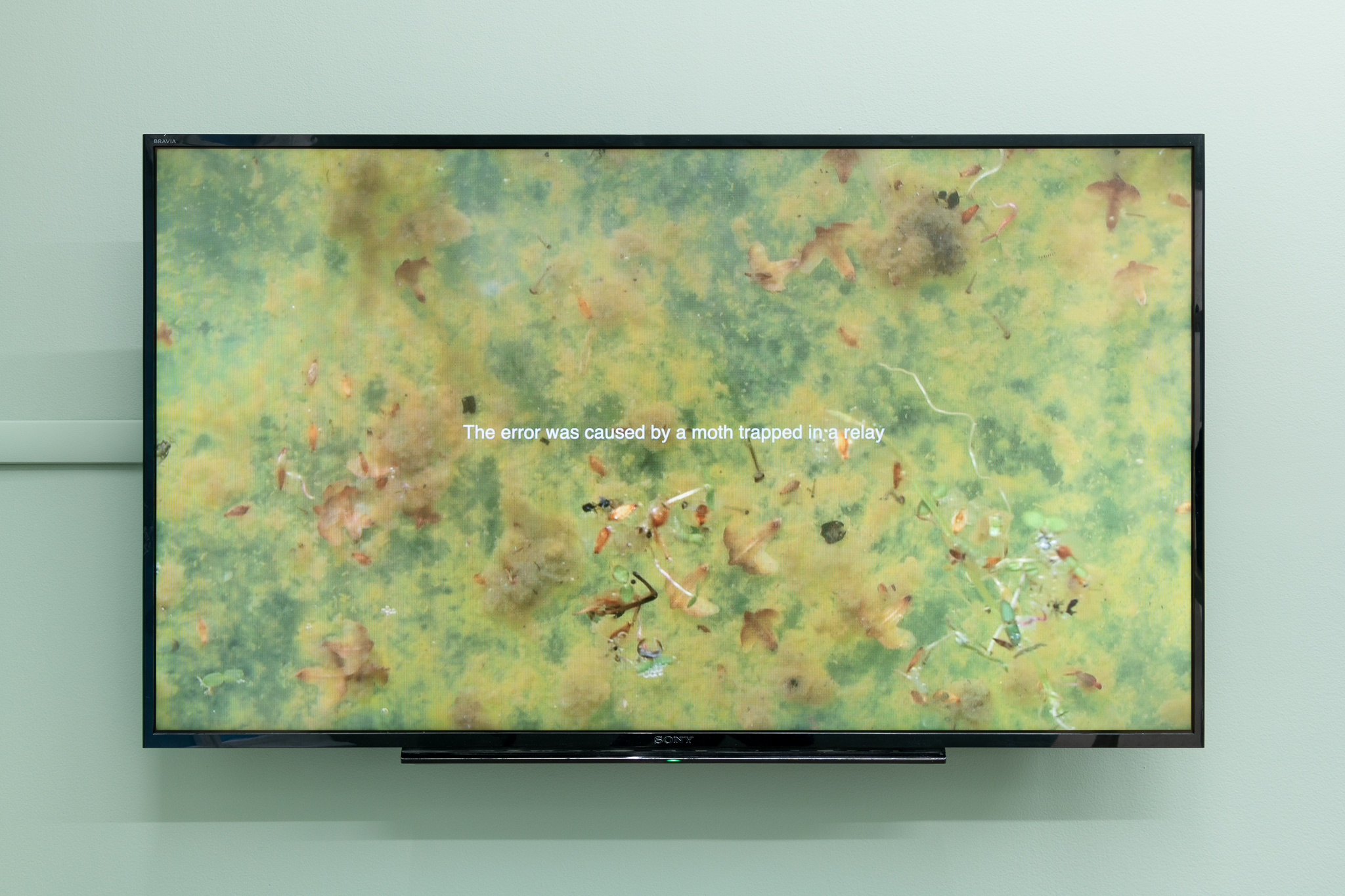 Installation detail, LCD monitor with video loop
Installation detail, LCD monitor with video loop
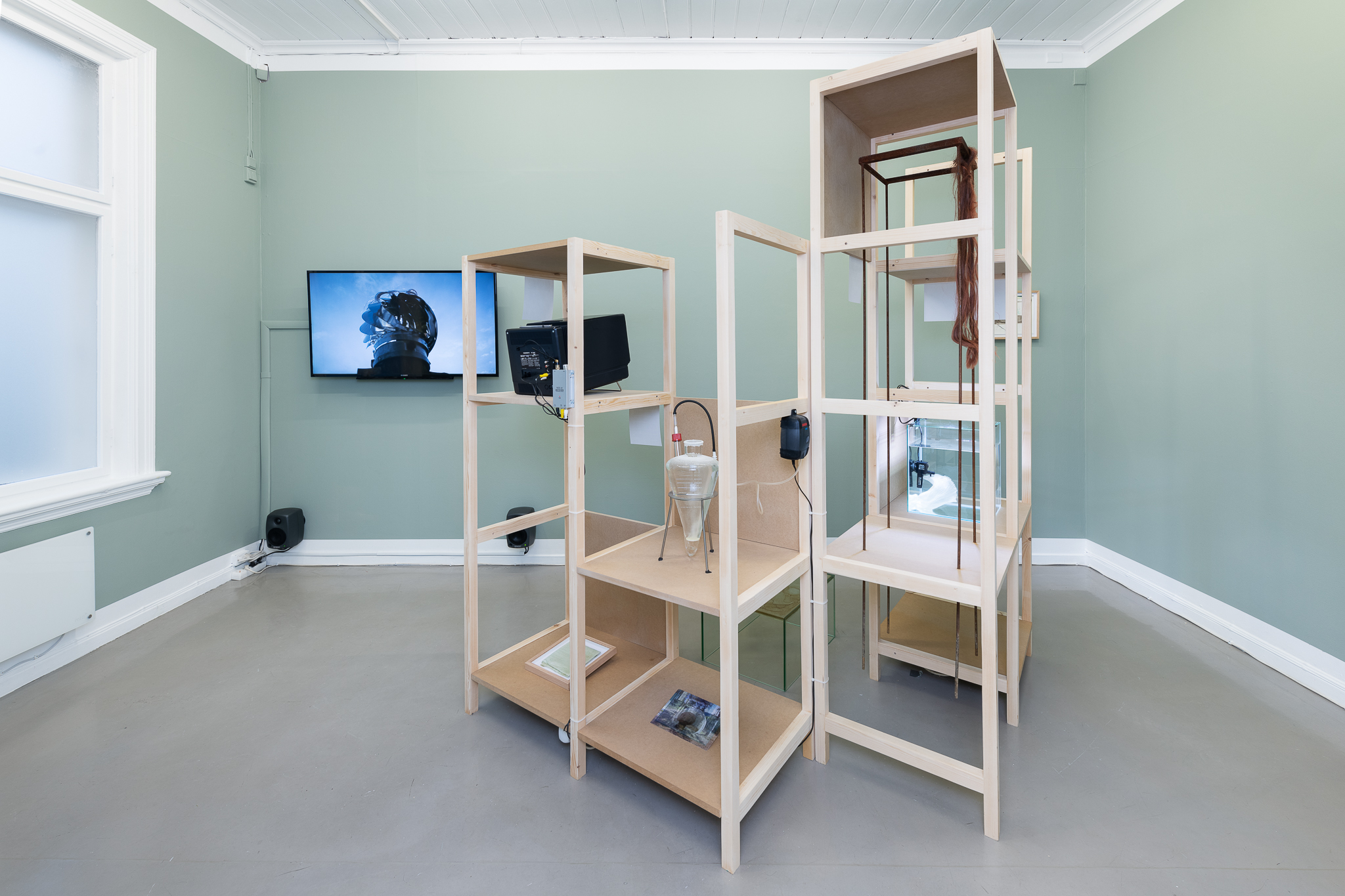 Installation view
Installation viewAll photos: Istvan Virag
Handout
by Martina Petrelli
Andrea Bakketun’s Grand Complications project finds its starting point in the artist’s two-year long residency at the Gamle Rommen skole (the Old Rommen school) in Oslo, and the corresponding long-term dialogue between her and biologist Peter Roessingh. Leading over the course of nature, the conversations started to find some sort of practical manifestations in constructing DIY sensory equipment. Designed to detect unpredictable and subtle changes in and around the Gamle Rommen skole, those kinetic sculptures began to visually translate hidden processes in the environment—emphasising Bakketun’s fascinated observations of all coexisting things in our present.
In watch-making, “Grand Complications” refers to watches with multiple complications and functions showing movements beyond time: portable time-pieces including split-seconds, moon phases, and perpetual calendars. Bakketun’s complications are not be worn on a wrist, but rather belong to site-specific rooms—allowing the visitor to step into a visual documentation of surrounding, parallel ongoing processes. In and around Akershus Kunstsenter, variables such as wind, light, snowfall, growth and decay influence the exhibition’s kinetic sculptures. By confronting us to this ever-changing mindfulness, the artist provides the opportunity for looking at our existence through evolving time scales.
The shelf construction which we find in Bakketun’s installation used to be the brain of Grand Complications. In the shelf are a number of elements documenting the one-year long project at Gamle Rommen skole, in addition to sculptures that process, translate and develop pieces of information from the art centre’s surroundings. A lab-flask is filled with a crystallising solution, outgrowing during the exhibition’s period. In an aquarium, a pump is connected and activated by an outdoors sculpture, which in turn is activated by wind. Behind the shelf, a stone which used to be placed behind a crystal-ball bears the scortched mark from its exposure to the sun. On a black-and-white screen we see real time images from the outdoor pinhole camera which points towards the sky.
On the wall, three watercolours are artist’s sketches previous to the start of Grand Complications, illustrating chain-reaction sculptures that never came to happen: growing plants to create an electrical circuit, algae in a lab set-up, spikes leaning over growing vegetables in order to stab them and start the process of decay. The room’s video- and text-works present a compilation of thoughts, recordings and diary entries from Grand Complications’ year.
Spreading across the art centre, two more kinetic sculptures can be discovered. Below the staircase an aquarium stimulates algae growing on elements picked around the centre, while the aquarium upstairs contains the first type of life on our planet: microorganisms. Those microscopic creatures are observed by a pinhole camera which signalises their presence with a sound every time one swims pass.
Grand Complications is an enthusiastic, amateurish laboratory—maybe best described as a form of re-search through practice. Through playful and poetic inventions, Bakketun observes site-specific presences and processes. As responses to our surroundings, the sculptures can also be perceived as visualisations of a different kind of communication. In contrast to the certainties of academic knowledge, her discoveries are diverse, sometimes incoherent—yet intriguing.
/
Et toårig residencyopphold ved Gamle Rommen skole i Oslo og en dialog med biologen Peter Roessingh over lengre tid, var starten på Andrea Bakketuns prosjekt Grand Complications. Samtalen med Roessingh dreide seg blant annet om prosesser i naturen, og hvorvidt det var mulig å registrere disse ved hjelp av selvlaget sensorisk utstyr. Resultatet ble kinetiske skulpturer konstruert for å fange opp endringer i og rundt Gamle Rommen skole, som vær, vekster og årstider. Bakketuns prosjekt kan forstås som visuelle oversettelser av slike forløp som vi finner i våre omgivelser, og studiene viser en dyp fascinasjon for de mange elementene som sameksisterer her og nå.
I urmakeryrket refererer begrepet «grand complications» til klokker som har komplekse funksjoner utover det å vise tid, som tiendedels sekunder, månefaser og uendelige kalendre. Imidlertid kan ikke Bakketuns «complications» bæres på armen, i stedet hører de hjemme i stedsspesifikke rom der de åpner for at betrakteren kan bevege seg inn og observere visuelle dokumentasjoner av prosesser som pågår parallelt. For de kinetiske skulpturene vi ser i utstillingen påvirkes av variabler i og omkring Akershus Kunstsenter, som vind, lys, snø, vekst og forråtnelse. I møte med disse stadige endringene, blir vi også oppmerksomme på vår egen tilstedeværelse i den store sammenhengen.
Hyllekonstruksjonen som vi ser i Bakketuns del av utstillingen, var opprinnelig «hjernen» i Grand Complications, og her ser vi se flere ulike elementer som dokumenterer det ettårige prosjektet som fant sted i Gamle Rommen skole. I tillegg finner vi skulpturer som i nåtid prosesserer, oversetter og utvikler deler av informasjonen som hentes inn fra kunstsenterets omgivelser.
I hyllen står blant annet en laboratorieflaske fylt med en krystalliserende løsning som vil endre seg i løpet av utstillingsperioden, og et akvarium med en pumpe som aktiviseres av en skulptur utendørs, som igjen trigges av vinden. Bak hyllen ligger en stein med svimerker fra solen etter at den opprinnelig var plassert bak en krystallkule og ble eksponert for lys, og på skjermer kan vi se direkteoverføringer fra et pinhole-kamera rettet mot himmelen som er plassert ute. I den store installasjonen finnes også korte tekster, tanker og dagboknotater fra Grand Complications.
På veggene henger tre akvareller, som er skisser Bakketun lagde forut for Grand Complications. Skissene illustrerer skulpturer for kjedereaksjoner som aldri ble realisert: Planter i vekst som på den måten skaper elektriske kretser; alger i et laboratorie-oppsett, pigger som lener seg over voksende grønnsaker for å kunne spidde dem og dermed starte forråtnelsesprosessen.
Rundt i kunstsenteret kan vi finne to kinetiske skulpturer til. Under trappen står et akvarium, som stimulerer til algevekst på ulike gjenstander funnet i området rundt kunstsenteret, mens akvariet i andre etasje inneholder den aller første livsformen på vår planet: mikroorganismer. De mikroskopiske skapningene observeres av et pinhole-kamera, som avgir en liten lyd hver gang de svømmer forbi.
Grand Complications fortoner seg som et amatøraktig, men entusiastisk laboratorium – muligens best beskrevet som en form for utforskning gjennom praksis. Med lekne og poetiske oppfinnelser observerer Bakketun ulike stedsspesifikke endringer, og som responser på våre omgivelser kan de mange skulpturene også betraktes som visualiseringer av ulike former for kommunikasjon. I motsetning til konvensjonell akademisk kunnskap, er Bakketuns oppdagelser mangfoldige og tidvis usammenhengende, men besnærende, og det er med glede vi inviterer til et nærstudie av detaljer hentet fra vår egen verden.